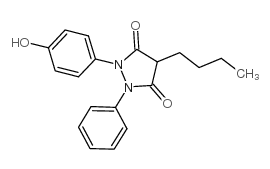Phospholipase A2 as a target protein for nonsteroidal anti-inflammatory drugs (NSAIDS): crystal structure of the complex formed between phospholipase A2 and oxyphenbutazone at 1.6 A resolution.
Nagendra Singh, Talat Jabeen, Rishi K Somvanshi, Sujata Sharma, Sharmistha Dey, Tej P Singh
Index: Biochemistry 43(46) , 14577-83, (2004)
Full Text: HTML
Abstract
Phospholipase A(2) (PLA(2); EC 3.1.1.4) is a key enzyme involved in the production of proinflammatory mediators known as eicosanoids. The binding of the substrate to PLA(2) occurs through a well-formed hydrophobic channel. To determine the viability of PLA(2) as a target molecule for the structure-based drug design against inflammation, arthritis, and rheumatism, the crystal structure of the complex of PLA(2) with a known anti-inflammatory compound oxyphenbutazone (OPB), which has been determined at 1.6 A resolution. The structure has been refined to an R factor of 0.209. The structure contains 1 molecule each of PLA(2) and OPB with 2 sulfate ions and 111 water molecules. The binding studies using surface plasmon resonance show that OPB binds to PLA(2) with a dissociation constant of 6.4 x 10(-8) M. The structure determination has revealed the presence of an OPB molecule at the binding site of PLA(2). It fits well in the binding region, thus displaying a high level of complementarity. The structure also indicates that OPB works as a competitive inhibitor. A large number of hydrophobic interactions between the enzyme and the OPB molecule have been observed. The hydrophobic interactions involving residues Tyr(52) and Lys(69) with OPB are particularly noteworthy. Other residues of the hydrophobic channel such as Leu(3), Phe(5), Met(8), Ile(9), and Ala(18) are also interacting extensively with the inhibitor. The crystal structure clearly reveals that the binding of OPB to PLA(2) is specific in nature and possibly suggests that the basis of its anti-inflammatory effects may be due to its binding to PLA(2) as well.
Related Compounds
| Structure | Name/CAS No. | Molecular Formula | Articles |
|---|---|---|---|
 |
G-29701
CAS:129-20-4 |
C19H20N2O3 |
|
Bone marrow depression due to mianserin, phenylbutazone, oxy...
1986-07-01 [Adverse Drug React. Acute Poisoning Rev. 5(2) , 97-136, (1986)] |
|
Bone marrow depression due to mianserin, phenylbutazone, oxy...
1986-10-01 [Adverse Drug React. Acute Poisoning Rev. 5(3) , 181-96, (1986)] |
|
Disposition and tolerance of suxibuzone in horses.
1999-09-01 [Equine Vet. J. 31(5) , 411-6, (1999)] |
|
Pharmacokinetics of phenylbutazone and its metabolite oxyphe...
2001-05-01 [Am. J. Vet. Res. 62(5) , 673-5, (2001)] |
|
Screening, quantification, and confirmation of phenylbutazon...
2009-01-01 [J. Anal. Toxicol. 33(1) , 41-50, (2009)] |